
NGC 7752 and NGC 7753 are a pair of galaxies approximately 272 million light-years away in the constellation Pegasus.
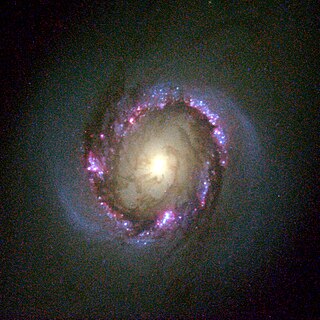
NGC 4314 is a barred spiral galaxy approximately 53 million light-years away in the northern constellation of Coma Berenices. It is positioned around 3° to the north and slightly west of the star Gamma Comae Berenices and is visible in a small telescope. The galaxy was discovered by German-born astronomer William Herschel on March 13, 1785. It was labelled as peculiar by Allan Sandage in 1961 because of the unusual structure in the center of the bar. NGC 4314 is a member of the Coma I group of galaxies.

Arp 272 is a pair of interacting galaxies consisting of the two spiral galaxies NGC 6050 (left) and IC 1179 (right). Arp 272 lies around 450 million light years from Earth in the constellation of Hercules. The galaxies are part of the Hercules Cluster, which is itself part of the CfA2 Great Wall.

NGC 3324 is an open cluster in the southern constellation Carina, located northwest of the Carina Nebula (NGC 3372) at a distance of 9,100 ly (2,800 pc) from Earth. It is closely associated with the emission nebula IC 2599, also known as Gum 31. The two are often confused as a single object, and together have been nicknamed the "Gabriela Mistral Nebula" due to its resemblance to the Chilean poet. NGC 3324 was first catalogued by James Dunlop in 1826.
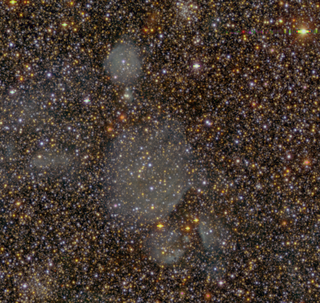
NGC 267 is an open cluster in the Small Magellanic Cloud. It is located in the constellation Tucana. It was discovered on October 4, 1836, by John Herschel.

NGC 285 is a lenticular galaxy in the constellation Cetus. It was discovered on October 2, 1886, by Francis Leavenworth.
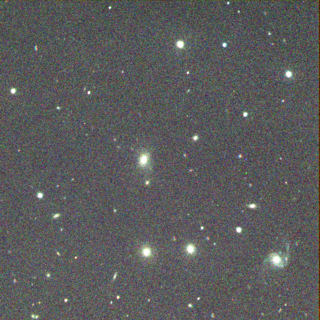
NGC 286 is a lenticular galaxy in the constellation Cetus. It was discovered on October 2, 1886 by Francis Leavenworth.

NGC 298 is a spiral galaxy in the constellation Cetus. It was discovered on September 27, 1864 by Albert Marth. NGC 298 is situated close to the celestial equator and, as such, it is at least partly visible from both hemispheres in certain times of the year. Given its B magnitude of 14.7, NGC 298 is visible with the help of a telescope having an aperture of 20 inches or more.

NGC 304 is a lenticular galaxy in the constellation Andromeda. It was discovered on October 23, 1878, by Édouard Stephan.

NGC 318 is a lenticular galaxy in the constellation Pisces. It was discovered on November 29, 1850 by Bindon Stoney.

NGC 327 is a spiral galaxy in the constellation Cetus. Also known as "The Jamie Smith Star" (ISD0534203) and was discovered on September 27, 1864 by Albert Marth. It is described by Dreyer as "faint, small, extended." It is nearby galaxies NGC 329, NGC 325 and NGC 321.
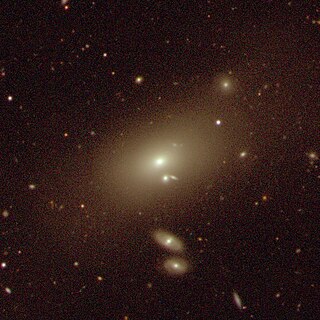
NGC 333 is a lenticular galaxy located approximately 755 million light years away in the constellation Cetus. It was discovered in 1877 by Wilhelm Tempel. It is recorded as NGC 333 in the New General Catalogue. It has a companion galaxy, named PGC 3073571, which is presumed to be a physical pair with NGC 333.

NGC 353 is a spiral galaxy in the constellation Cetus. It was discovered on November 10, 1885 by Lewis Swift. It was described by Dreyer as "extremely faint, pretty small, round, southeastern of 2.", the other being NGC 351.

NGC 364 is a barred lenticular galaxy in the constellation Cetus. It was discovered on September 2, 1864, by Albert Marth. It was described by Dreyer as "very faint, very small."
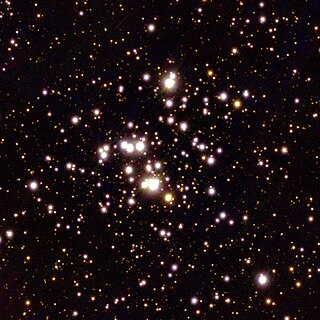
NGC 366 is an open cluster located in the constellation Cassiopeia. It was discovered on October 27, 1829, by John Herschel. It was described by Dreyer as a "cluster, small."
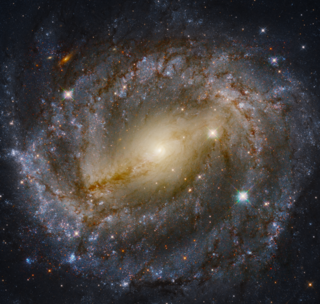
NGC 5643 is an intermediate spiral galaxy in the constellation Lupus. Based on the tip of the red-giant branch distance indicator, it is located at a distance of about 40 million light-years. NGC 5643 has an active galactic nucleus and is a type II Seyfert galaxy.

NGC 7035 and NGC 7035A are a pair of interacting lenticular galaxies located around 400 to 430 million light-years away in the constellation of Capricornus. The main galaxy, NGC 7035 was discovered by astronomer Frank Muller in 1886.
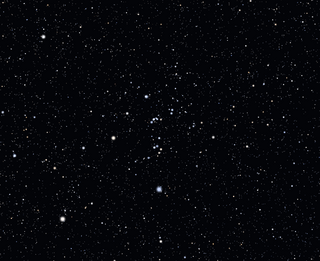
NGC 5460 is an open cluster in the constellation Centaurus. It is a bright but loose cluster of intermediate age located approximately 2,300 light years away from Earth. It is located nearly 2 degrees east-southeast of Zeta Centauri.

NGC 6040 is a spiral galaxy located about 550 million light-years away in the constellation Hercules. NGC 6040 was discovered by astronomer Édouard Stephan on June 27, 1870. NGC 6040 is interacting with the lenticular galaxy PGC 56942. As a result of this interaction, NGC 6040's southern spiral arm has been warped in the direction toward PGC 56942. NGC 6040 and PGC 56942 are both members of the Hercules Cluster.

NGC 3311 is a super-giant elliptical galaxy located about 190 million light-years away in the constellation Hydra. The galaxy was discovered by astronomer John Herschel on March 30, 1835. NGC 3311 is the brightest member of the Hydra Cluster and forms a pair with NGC 3309 which along with NGC 3311, dominate the central region of the Hydra Cluster.




















